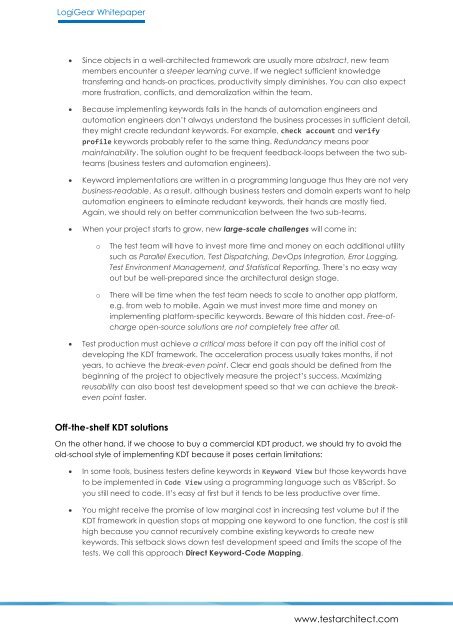The Evolution of Keyword Driven Testing
Create successful ePaper yourself
Turn your PDF publications into a flip-book with our unique Google optimized e-Paper software.
LogiGear Whitepaper<br />
<br />
<br />
<br />
<br />
Since objects in a well-architected framework are usually more abstract, new team<br />
members encounter a steeper learning curve. If we neglect sufficient knowledge<br />
transferring and hands-on practices, productivity simply diminishes. You can also expect<br />
more frustration, conflicts, and demoralization within the team.<br />
Because implementing keywords falls in the hands <strong>of</strong> automation engineers and<br />
automation engineers don’t always understand the business processes in sufficient detail,<br />
they might create redundant keywords. For example, check account and verify<br />
pr<strong>of</strong>ile keywords probably refer to the same thing. Redundancy means poor<br />
maintainability. <strong>The</strong> solution ought to be frequent feedback-loops between the two subteams<br />
(business testers and automation engineers).<br />
<strong>Keyword</strong> implementations are written in a programming language thus they are not very<br />
business-readable. As a result, although business testers and domain experts want to help<br />
automation engineers to eliminate redudant keywords, their hands are mostly tied.<br />
Again, we should rely on better communication between the two sub-teams.<br />
When your project starts to grow, new large-scale challenges will come in:<br />
o<br />
o<br />
<strong>The</strong> test team will have to invest more time and money on each additional utility<br />
such as Parallel Execution, Test Dispatching, DevOps Integration, Error Logging,<br />
Test Environment Management, and Statistical Reporting. <strong>The</strong>re’s no easy way<br />
out but be well-prepared since the architectural design stage.<br />
<strong>The</strong>re will be time when the test team needs to scale to another app platform,<br />
e.g. from web to mobile. Again we must invest more time and money on<br />
implementing platform-specific keywords. Beware <strong>of</strong> this hidden cost. Free-<strong>of</strong>charge<br />
open-source solutions are not completely free after all.<br />
<br />
Test production must achieve a critical mass before it can pay <strong>of</strong>f the initial cost <strong>of</strong><br />
developing the KDT framework. <strong>The</strong> acceleration process usually takes months, if not<br />
years, to achieve the break-even point. Clear end goals should be defined from the<br />
beginning <strong>of</strong> the project to objectively measure the project’s success. Maximizing<br />
reusability can also boost test development speed so that we can achieve the breakeven<br />
point faster.<br />
Off-the-shelf KDT solutions<br />
On the other hand, if we choose to buy a commercial KDT product, we should try to avoid the<br />
old-school style <strong>of</strong> implementing KDT because it poses certain limitations:<br />
<br />
<br />
In some tools, business testers define keywords in <strong>Keyword</strong> View but those keywords have<br />
to be implemented in Code View using a programming language such as VBScript. So<br />
you still need to code. It’s easy at first but it tends to be less productive over time.<br />
You might receive the promise <strong>of</strong> low marginal cost in increasing test volume but if the<br />
KDT framework in question stops at mapping one keyword to one function, the cost is still<br />
high because you cannot recursively combine existing keywords to create new<br />
keywords. This setback slows down test development speed and limits the scope <strong>of</strong> the<br />
tests. We call this approach Direct <strong>Keyword</strong>-Code Mapping.<br />
www.testarchitect.com


